As summer days stretch and gardens burst with color, why let the party fizzle when fall arrives? There’s still a way.
⬇️ Plant these late-blooming beauties now and enjoy waves of vibrant petals right through the crisp air. ⬇️
Annuals
1. Zinnia (Zinnia elegans)
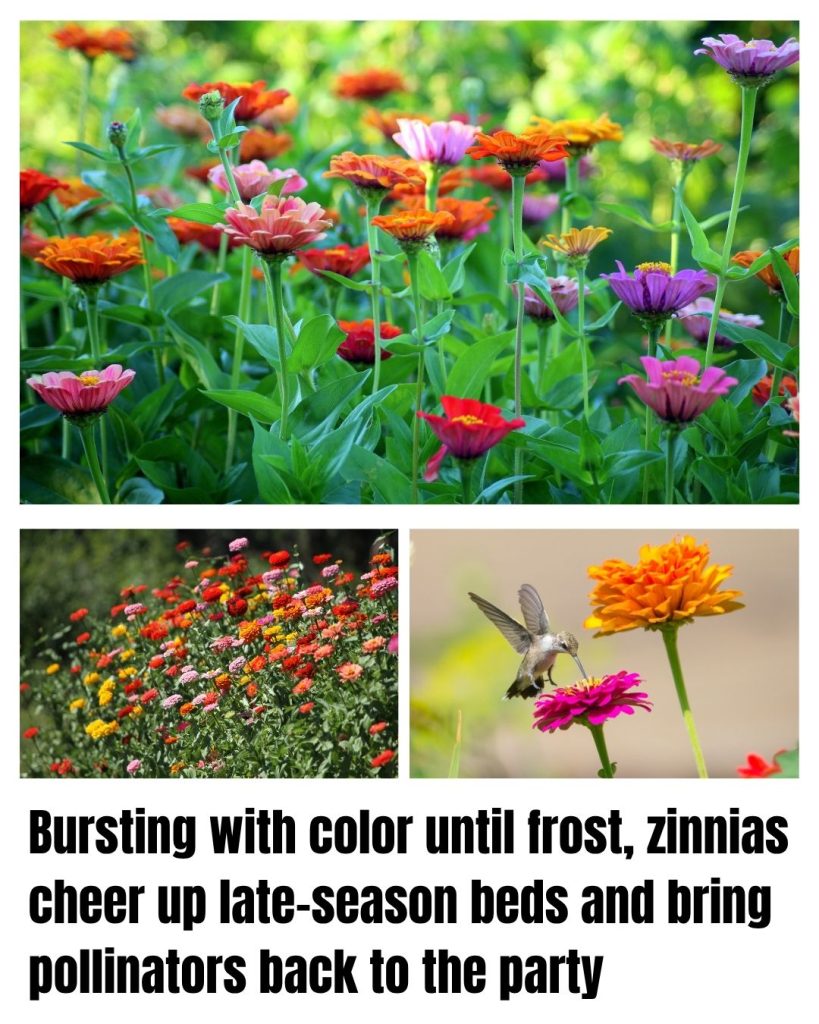
- Vibrant Daisy-Like Blooms appear in every hue, from fiery red to sunny yellow.
- Nonstop Color from midsummer until the first frost with minimal fuss.
- Pollinator Magnet draws in butterflies and bees while deterring some garden pests.
Zinnias produce bold, daisy-like flowers on sturdy stems that shine until frost. They pair well with cosmos and ornamental grasses, adding texture and movement.
Thriving in USDA zones 3-10, they love full sun and well-drained soil. Remove spent blooms to encourage nonstop color.
Perfect in beds, borders, or containers for some late-season cheer.
2. Cosmos (Cosmos bipinnatus)
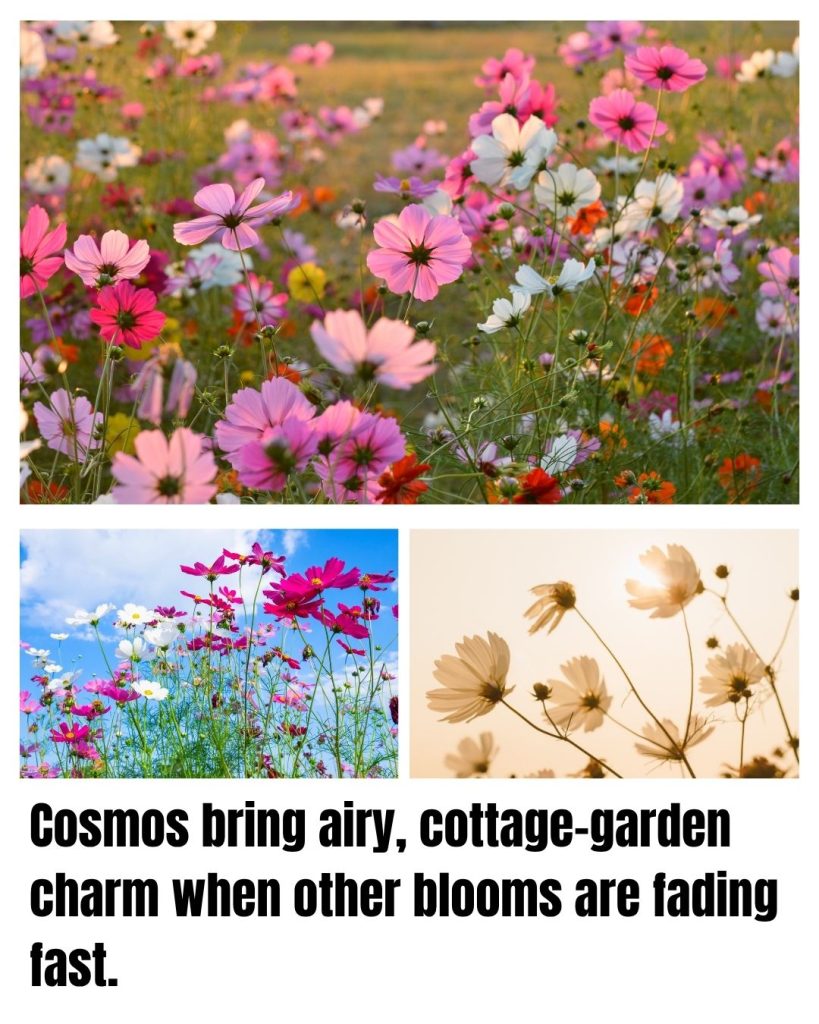
- Airy, Fern-Like Foliage adds texture and lightness to borders.
- Long-Blooming Daisies in pink, white and crimson from midsummer to frost.
- Drought Tolerant thrives in poor soil with minimal care.
Cosmos produce delicately textured foliage topped with daisy-like flowers in shades of pink, white and crimson. They pair well with zinnias and marigolds for a cottage-garden feel.
Thriving in USDA zones 2-11, they tolerate poor soil and drought and prefer full sun and good drainage.
Ideal in cutting gardens and containers for late-season grace.
3. Celosia (Celosia cristata)
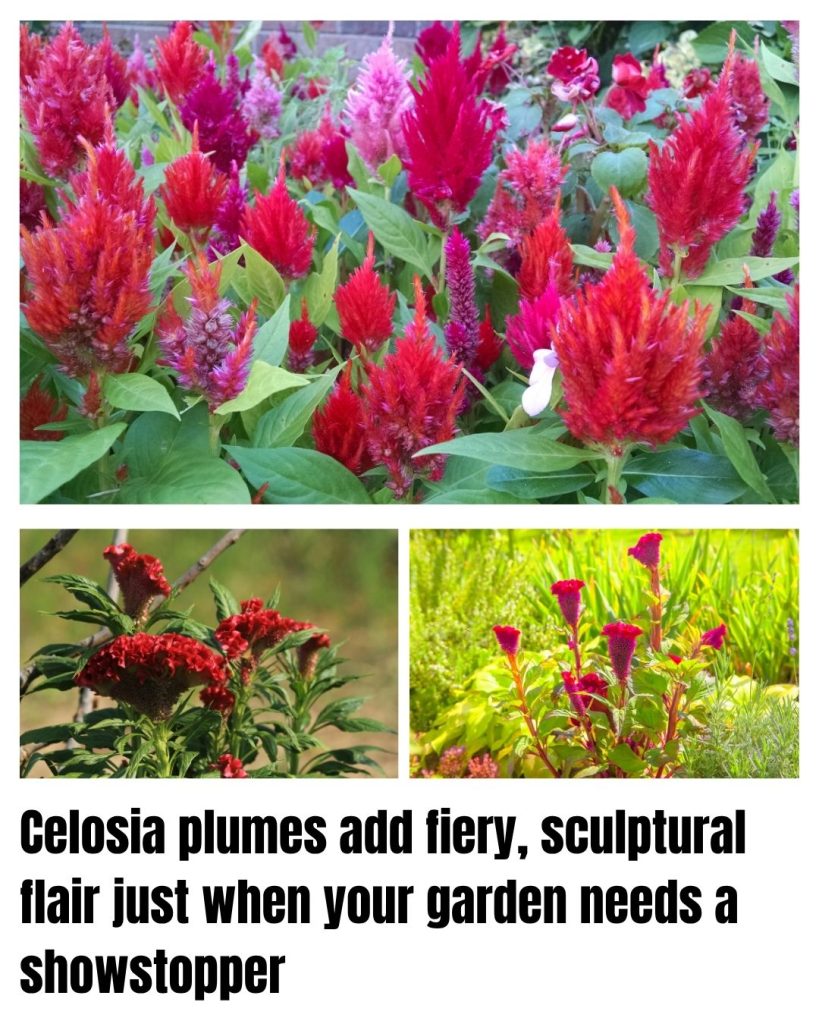
- Flame-Like Plumes resemble fiery crests in reds, oranges and pinks.
- Extended Bloom Period from midsummer through first frost.
- Heat Loving thrives in hot, humid conditions.
Celosia produce dramatic, plume-shaped flowers that add sculptural interest to garden beds. They pair well with salvia and ornamental peppers to highlight bold color contrasts.
Grow as an annual in USDA zones 2-11 (perennial in 10-11). They love full sun and well-drained soil, and deadheading boosts bloom quantity.
Perfect in beds and containers for late-season drama.
4. Globe Amaranth (Gomphrena globosa)
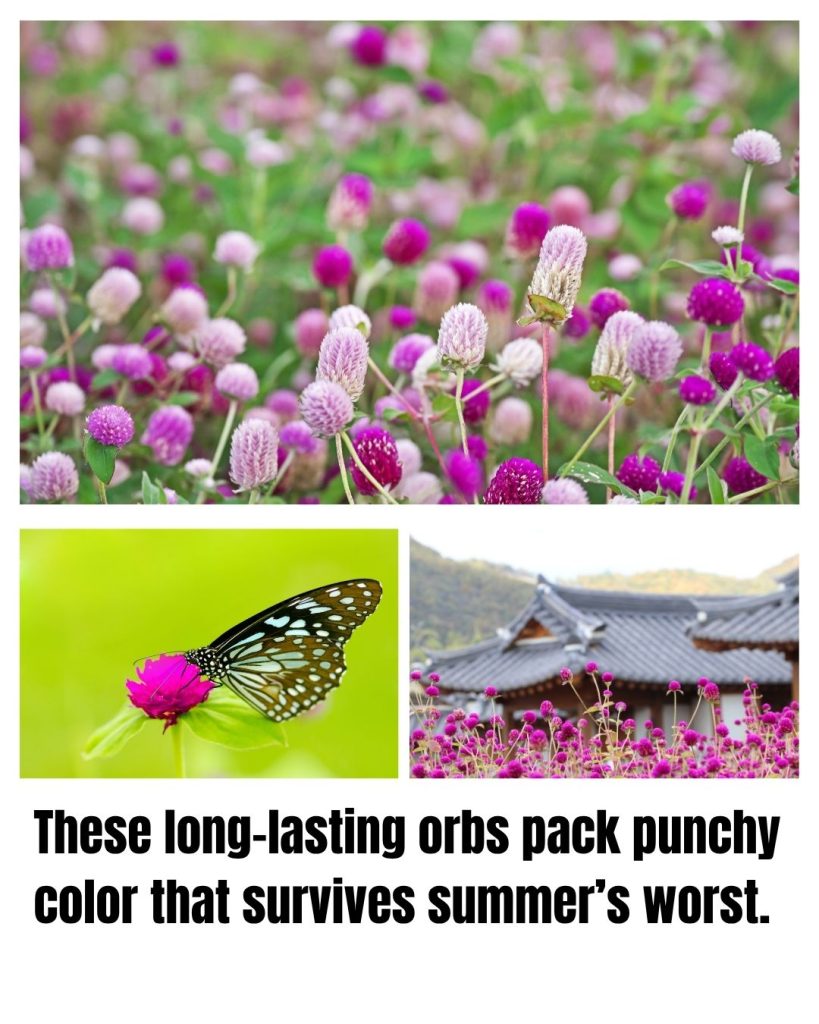
- Paper-Like Blooms retain vibrant color when dried.
- Heat and Drought Resistant ideal for summer heat.
- Compact Habit fits neatly in containers and edging.
Globe amaranth features round, clover-like blooms in shades of pink, magenta and white. They pair nicely with lantana and ornamental grasses for a playful texture mix.
Thriving in USDA zones 2-11, they prefer full sun and well-drained soil and tolerate heat, humidity and poor soil.
Great fresh or dried for everlasting bouquets.
5. Tithonia (Mexican Sunflower)
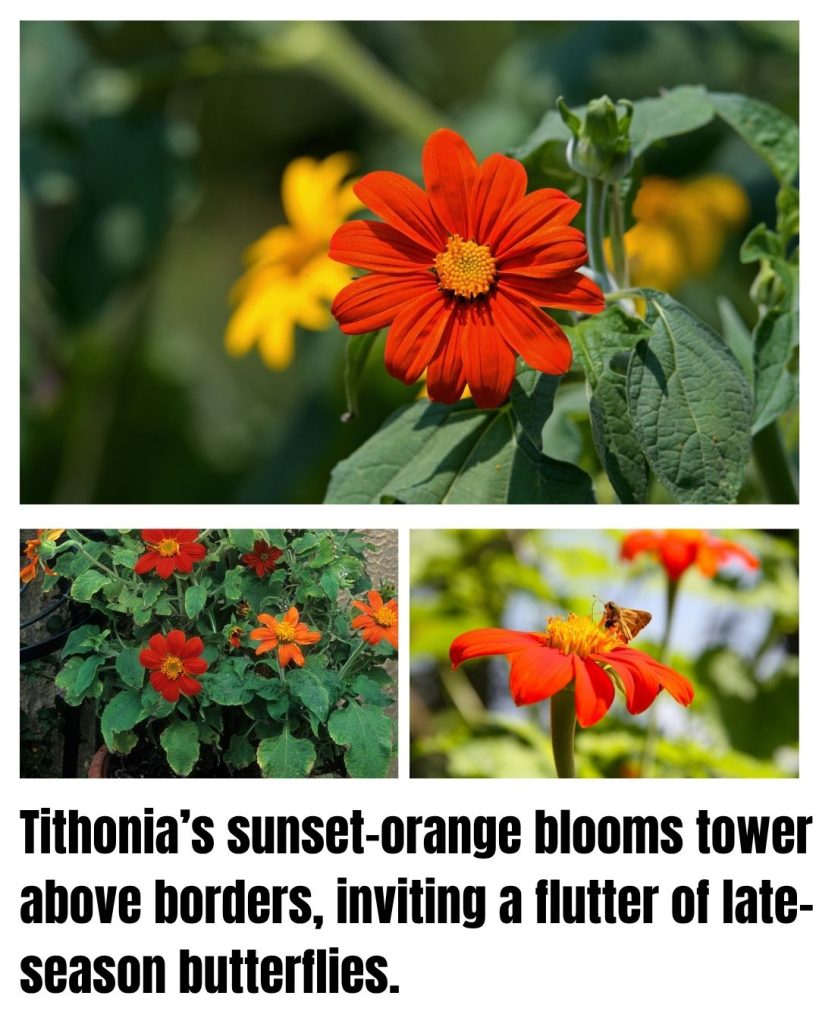
- Fiery Orange Daisies that light up late-season beds.
- Butterfly Magnet drawing monarchs and swallowtails.
- Tall Stature reaching up to four feet for vertical interest.
Tithonia produces bold, sunset-orange daisy-like flowers that stand out in late gardens.
They pair beautifully with purple asters and blue salvias for a striking color contrast.
Thriving as an annual in USDA zones 9-11 (or grown as an annual elsewhere), they love full sun and well-drained soil and attract pollinators.
Ideal for cutting and garden drama.
6. Marigold (Tagetes spp.)
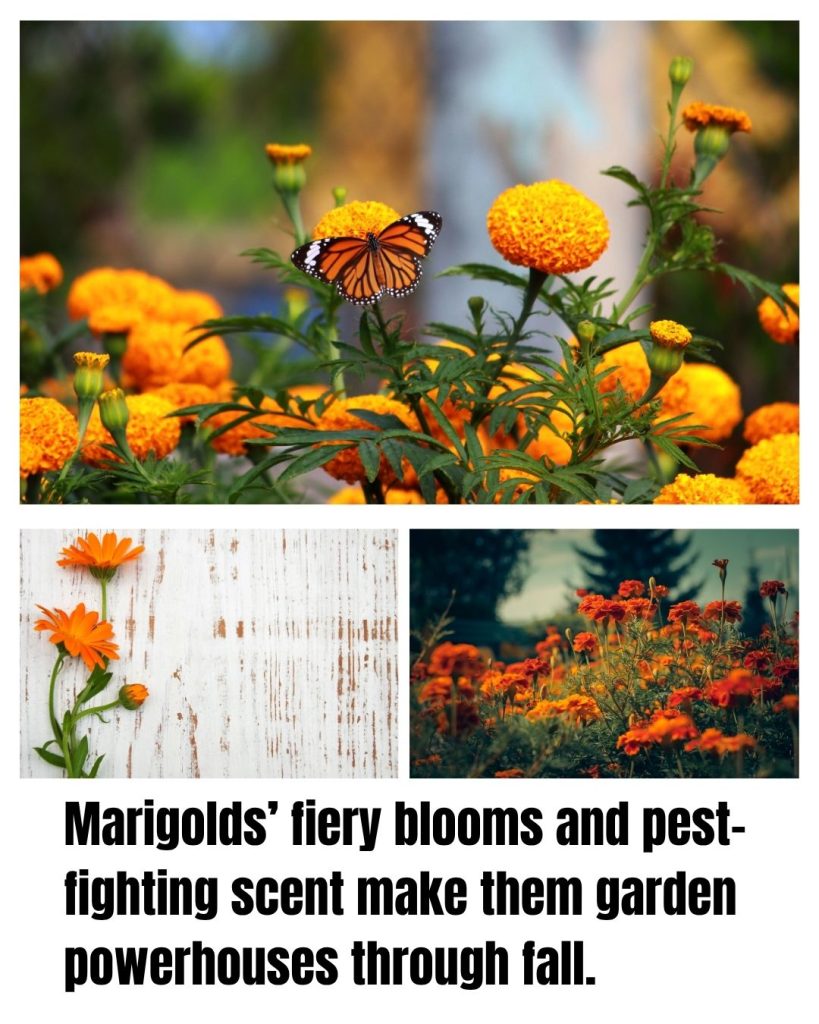
- Pest-Repelling Blooms marigolds deter nematodes and attract beneficial insects.
- Firecracker Colors bright oranges, golds and bi-colors that light up beds.
- Fast-Growing flowers appear just 6-8 weeks after transplanting.
Marigolds produce fragrant, daisy-like flowers on bushy plants. They pair well with basil and zinnias to boost garden color and health.
Thriving in USDA zones 211, they love full sun and well-drained soil, making care a breeze.
Perfect in borders, containers or planted alongside vegetables for natural pest control
7. ortulaca (Portulaca grandiflora)
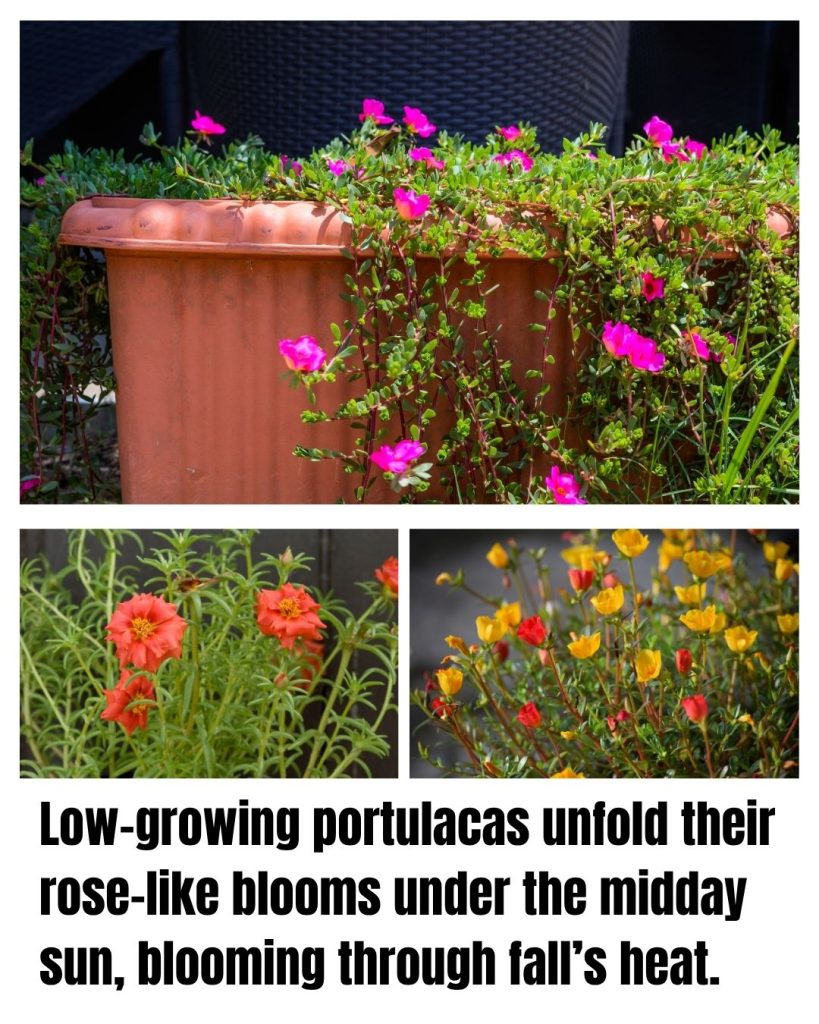
- Succulent Foliage water-storing leaves stay lush in heat.
- Midday Blooms, with flowers open with the sun and close at night.
- Heat Proof thrives in scorching temps and poor soil.
Portulaca brings rose-like blooms atop low, succulent mats. They pair nicely with petunias and sweet potato vine for contrasting textures.
Grown as an annual in USDA zones 9-11, they require full sun and very well-drained soil.
Ideal for rock gardens, containers, or edging where heat tolerance is key.
8. Annual Salvia (Salvia farinacea)
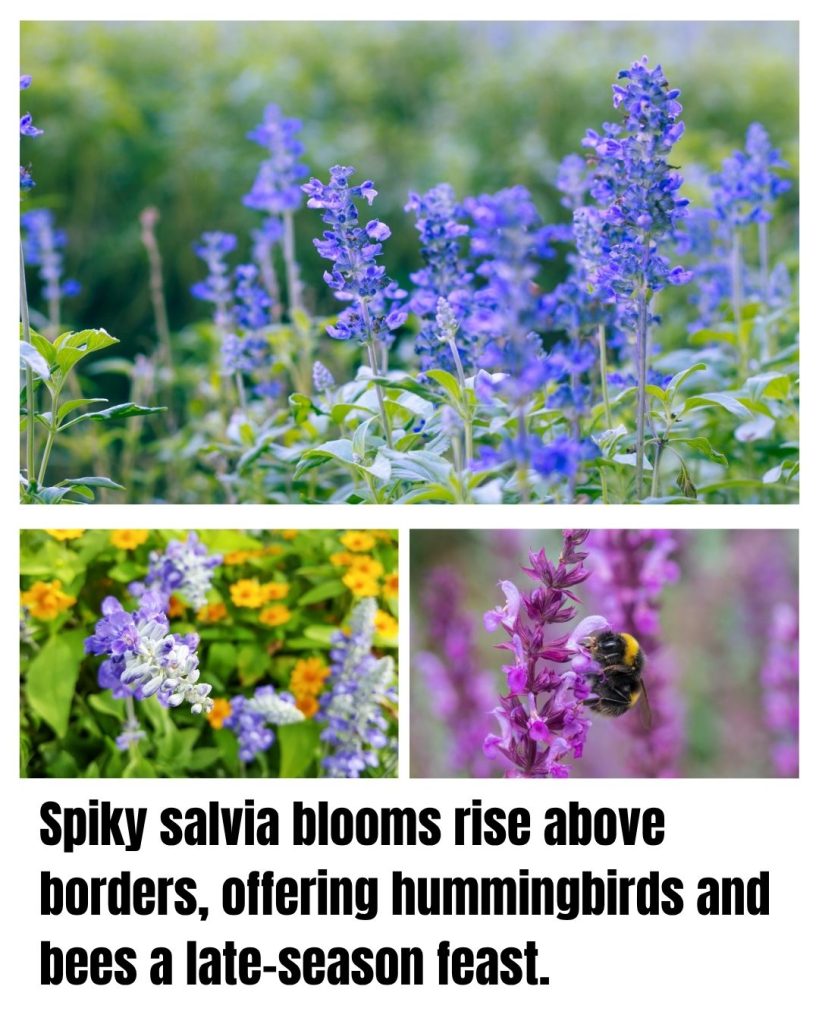
- Spiky Flower Spires– tall blue or violet blooms add vertical interest.
- Pollinator Favorite– hummingbirds and bees flock to the nectar.
- Reblooming Habit– deadheading encourages continuous flowering.
Annual salvia produces slender flower spikes that stand out in late beds. They pair well with gaillardia and coreopsis for a vibrant color mix.
Thriving in USDA zones 6-10 (grown as an annual elsewhere), they prefer full sun and well-drained soil.
Perfect for borders and cutting gardens to extend summer color.
9. Dahlia (tubers planted midsummer)
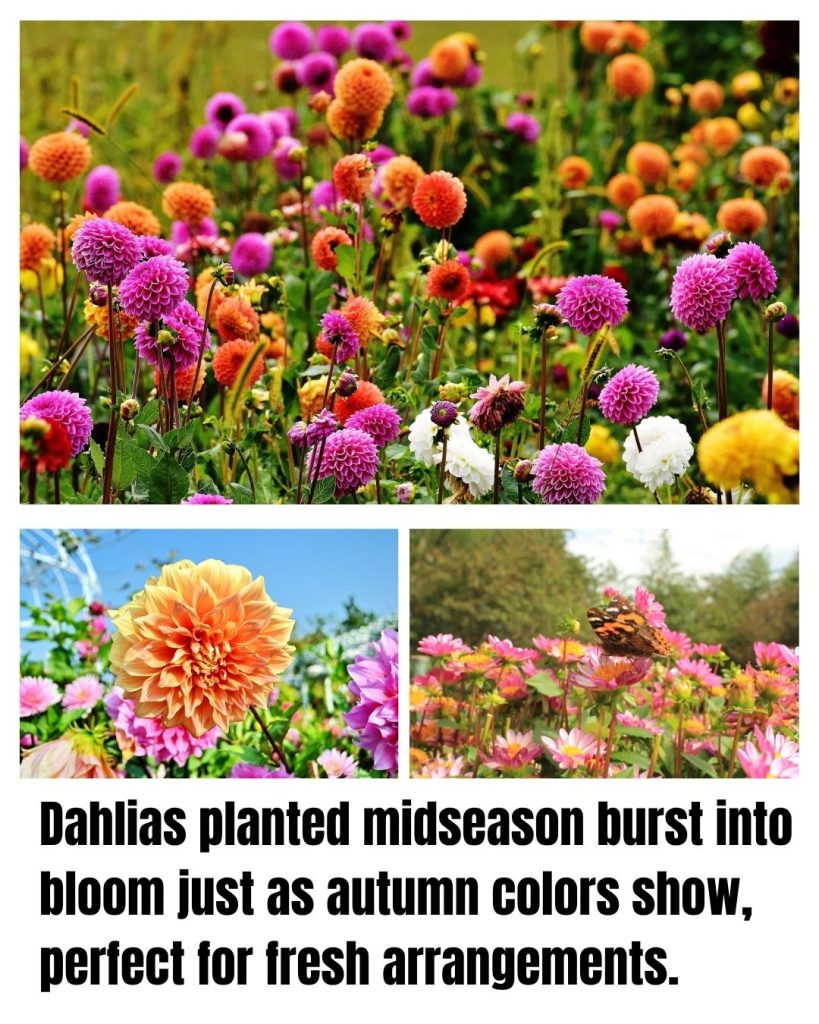
- Bold Flower Heads– showy blooms in every color fill late beds.
- Tuberous Roots– store energy for spectacular autumn flowering.
- Cut-Flower Darling– long stems and vibrant petals make great bouquets.
Summer-planted dahlia tubers burst into bloom as fall arrives. They pair beautifully with asters and ornamental grasses for texture and contrast.
Thriving in USDA zones 8-11 (dig and store tubers in colder zones), they require full sun and rich, well-drained soil.
Ideal in beds and containers for a last flurry of color.
10. Rudbeckia (Annual Coneflower)
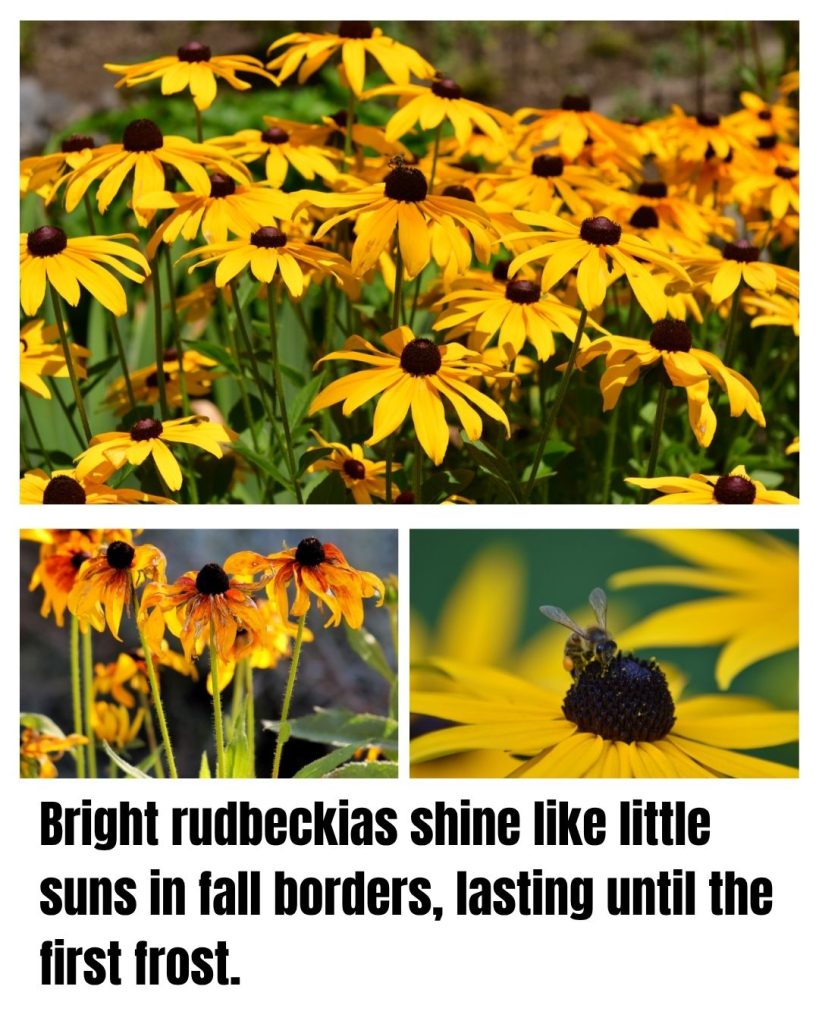
- Golden Petals– bright yellow rays with dark centers light up beds.
- Heat Tolerant– stands up to summer’s peak temperatures.
- Long Bloom– flowers persist from midsummer until frost.
Annual rudbeckia produces cheerful daisy-like flowers that brighten autumn borders. They pair well with salvias and zinnias for a warm color palette.
Thriving in USDA zones 2-11, they love full sun and average, well-drained soil.
Perfect in mass plantings or mixed containers for nonstop fall cheer.
11. Bachelor’s Button (Centaurea cyanus)
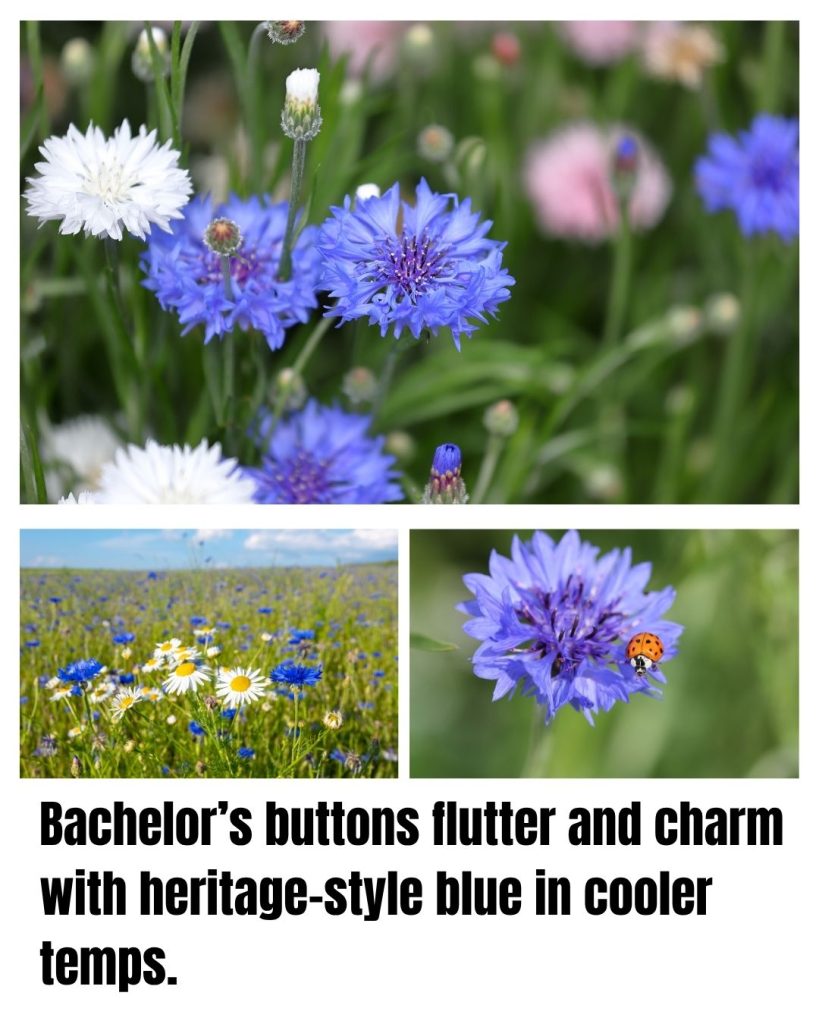
- Heritage Charm– classic cornflower blue (plus pink and white) blooms with old-world appeal.
- Pollinator Favorite– bees and butterflies flock to the delicate flowers.
- Cool-Season Tolerance– thrives in cooler weather and blooms until frost.
Bachelor’s buttons produce papery, daisy-style blooms atop slender stems that sway in the breeze.
They pair well with ornamental grasses and dahlias, adding soft texture to late beds.
Growing easily in USDA zones 2-11, they prefer full sun and well-drained soil. Deadhead to prolong flowering and prevent self-seeding if unwanted.
12. Sunflower (Dwarf Varieties)
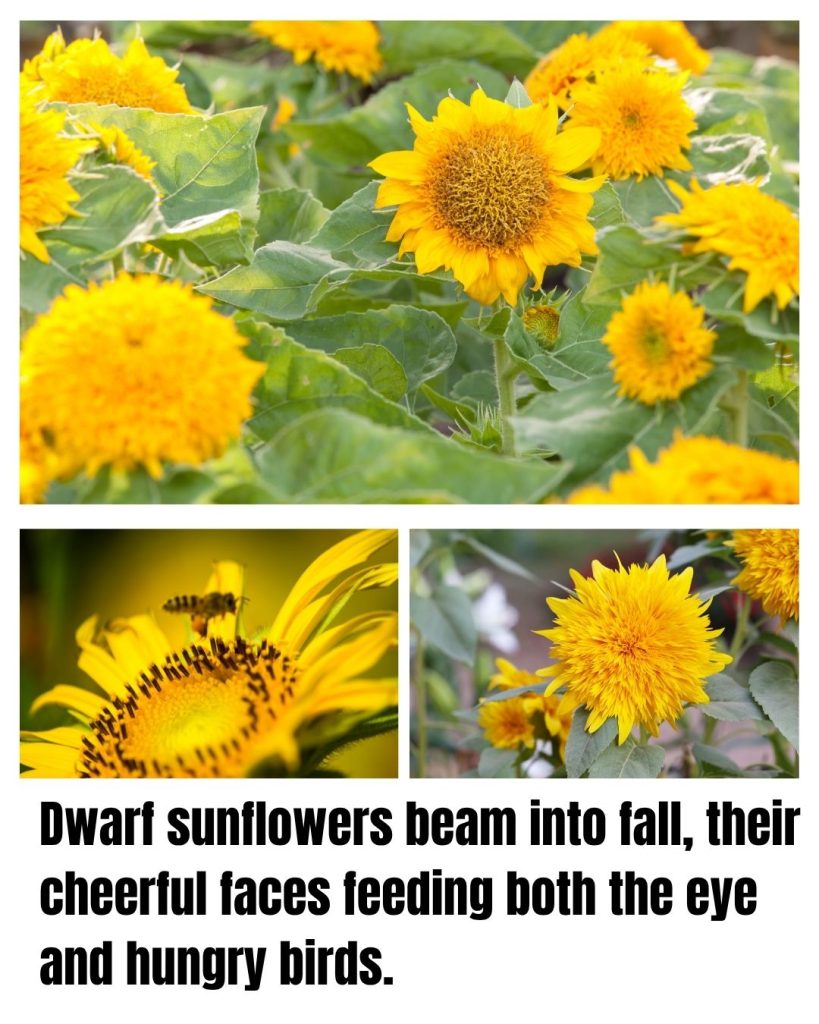
- Compact Height– reaches just 1-3 feet, perfect for borders and containers.
- Late-Season Blooms– flower heads open from late summer into fall.
- Wildlife Magnet– seeds feed finches, sparrows, and other birds.
Dwarf sunflowers offer bright, sunny faces that light up gardens and patios.
They pair beautifully with marigolds and zinnias for a cheerful late-season display.
Thriving in USDA zones 4-10, they require full sun and regular watering.
Cut spent heads or leave them to provide seeds for wildlife.
Perennials
13. Asters (Symphyotrichum spp.)
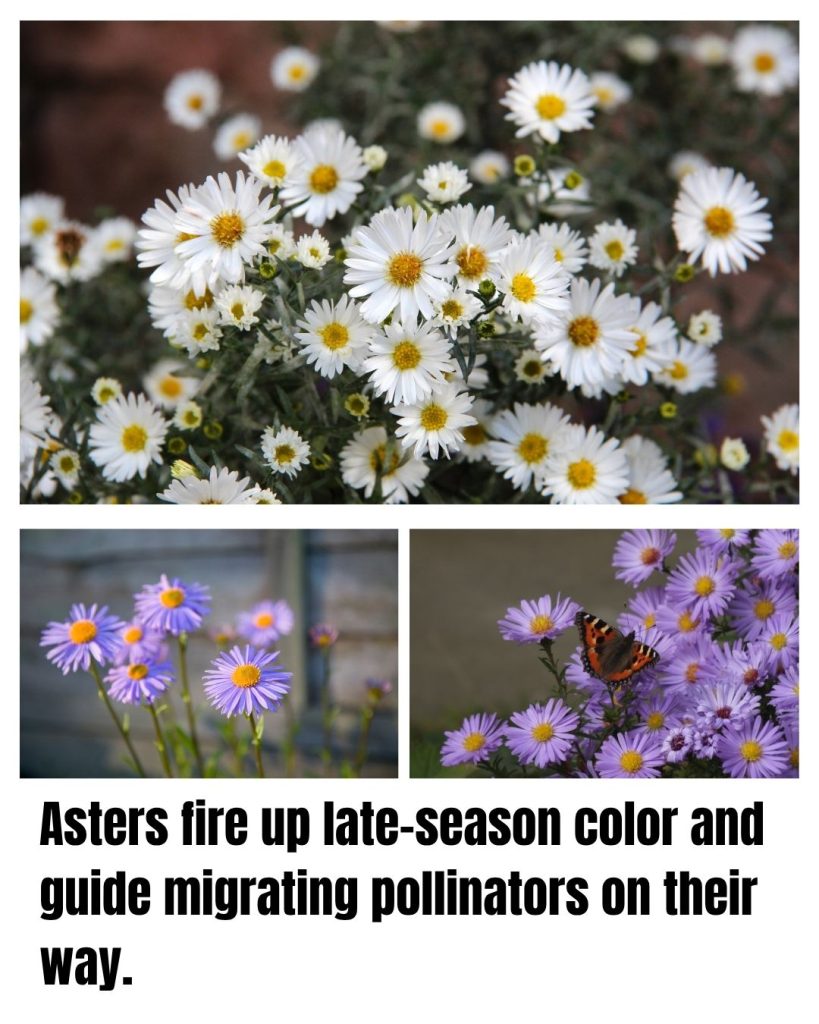
- Late-Season Daisies burst in purple, pink and white when most other blooms fade.
- Butterfly Magnet—feeds migrating monarchs and other pollinators.
- Low Maintenance—tolerates average soil and requires minimal care.
Asters produce daisy-like flowers on clumping plants that light up borders in fall. They pair beautifully with ornamental grasses and sedums for texture contrast, thriving in mixed beds or cutting gardens.
Hardy in USDA zones 3-8, they prefer full sun to part shade and average, well-drained soil. Divide clumps every few years to maintain vigor.
“Asters bring a final burst of daisy-like color, guiding pollinators through autumn’s chill.”
14. Sedum ‘Autumn Joy’ (Hylotelephium telephium)
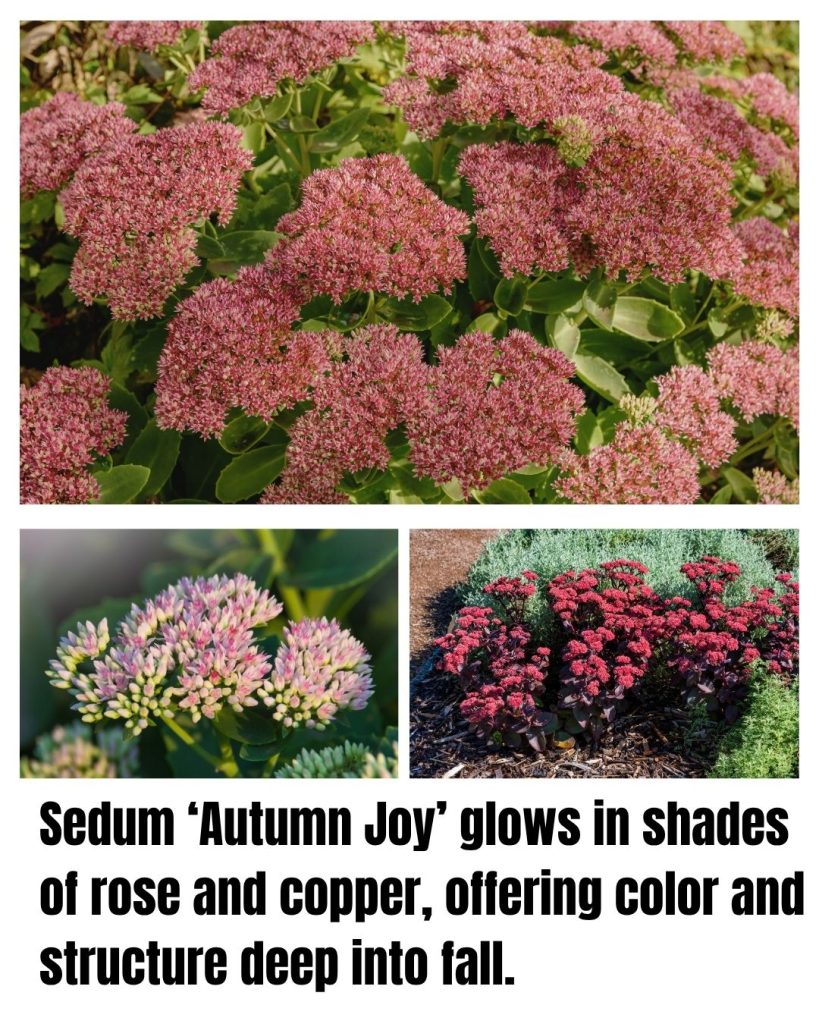
- Rich Rose-Pink Clusters age to copper and bronze.
- Drought-tolerant once established, needs little water.
- Winter Interest– stems hold seed heads that persist after frost.
Sedum ‘Autumn Joy’ forms succulent-leafed mounds topped with flat clusters that transition from pink to copper.
It pairs well with asters and ornamental grasses to balance bold texture.
Thriving in USDA zones 3-9, it loves full sun and well-drained soil. Cut back stems in spring to encourage fresh growth.
15. Chrysanthemum (Garden Mum)
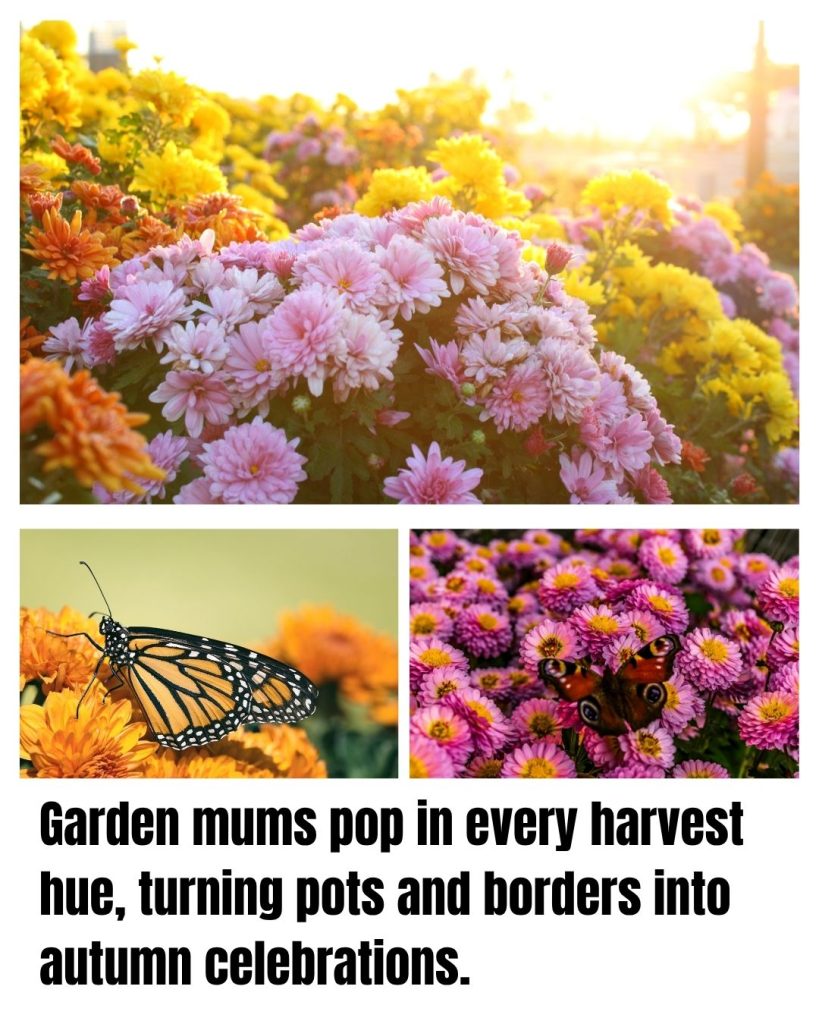
- Fall Star blooms in apricot, gold, burgundy and white.
- Wide Variety– numerous cultivars suit borders, containers or cutting.
- Pollinator Friendly– late-season nectar source for bees.
Garden mums produce bushy plants covered in pompom or daisy-like blooms.
They pair with ornamental kale and pansies in containers or mass plantings for vibrant fall displays.
Adapted to USDA zones 5-9, they prefer full sun and rich, well-drained soil. Pinch back in summer to promote branching and compact growth.
16. Coneflower (Echinacea purpurea)
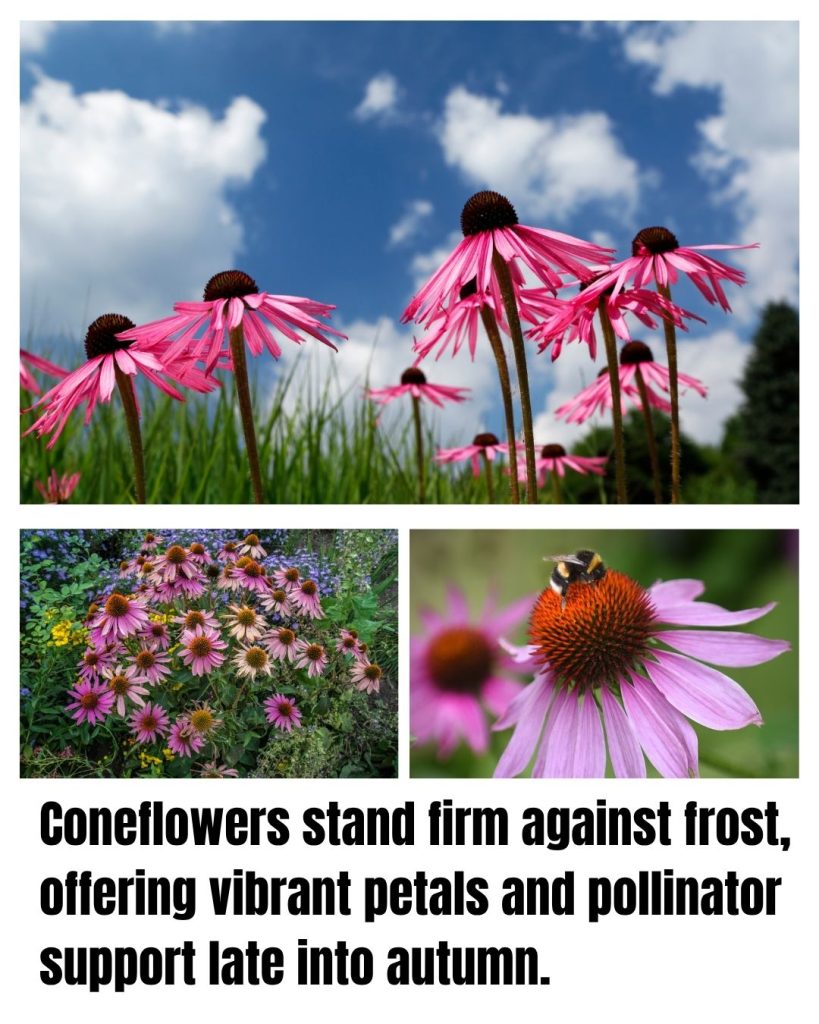
- Sturdy Pink-Purple Blooms stand tall from midsummer to frost.
- Drought Resistant once established, thrives with little water.
- Medicinal Roots-0native remedy ingredient traditionally used for immune support.
Coneflowers offer bold, daisy-like flowers on strong stems.
They pair well with black-eyed susans and Russian sage, creating a classic prairie-style border.
Hardy in USDA zones 39, they prefer full sun and average, well-drained soil. Deadhead spent blooms to encourage reblooming.
17. Helenium (Sneezeweed)
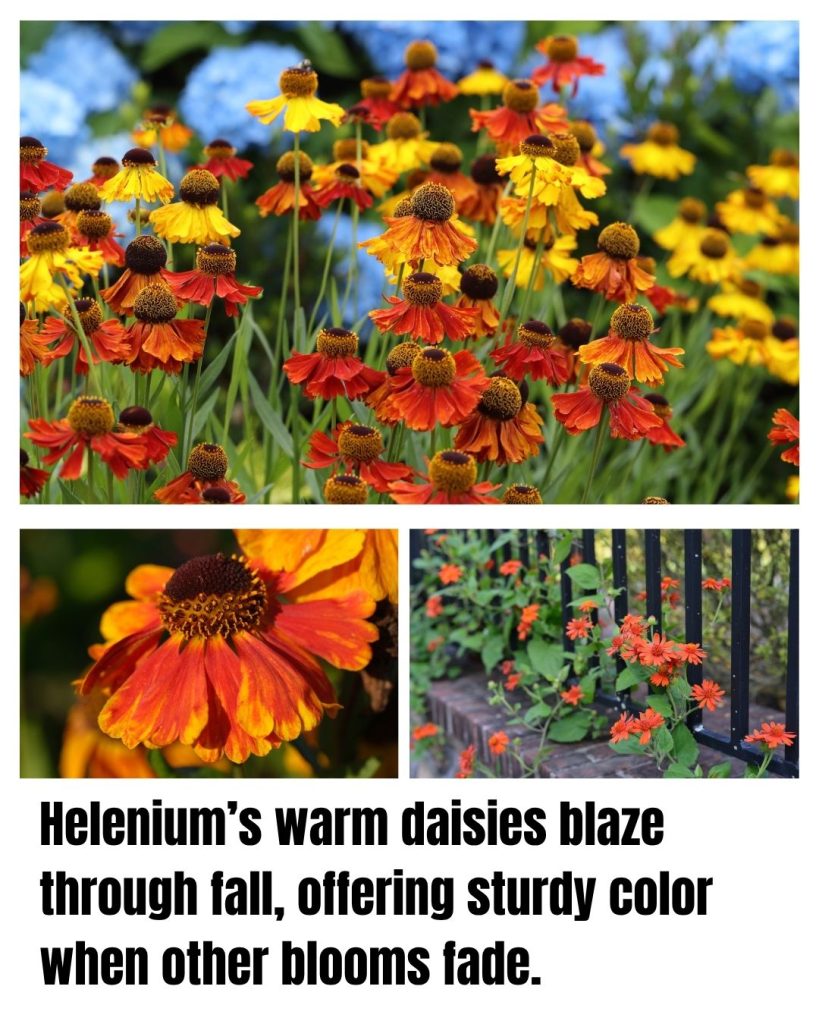
- Warm Daisy-Like Flowers in yellow, orange and red deep into October.
- Butterfly Attraction– pollinators flock to its nectar-rich blooms.
- Sturdy Stems resist wind and rain.
Helenium produces rich-colored blooms that nod on tall stalks.
They pair beautifully with asters and ornamental grasses for layered color and texture.
Growing in USDA zones 4-9, they prefer full sun and moist, well-drained soil. Divide every few years to maintain vigor.
18. Black-Eyed Susan (Rudbeckia fulgida)
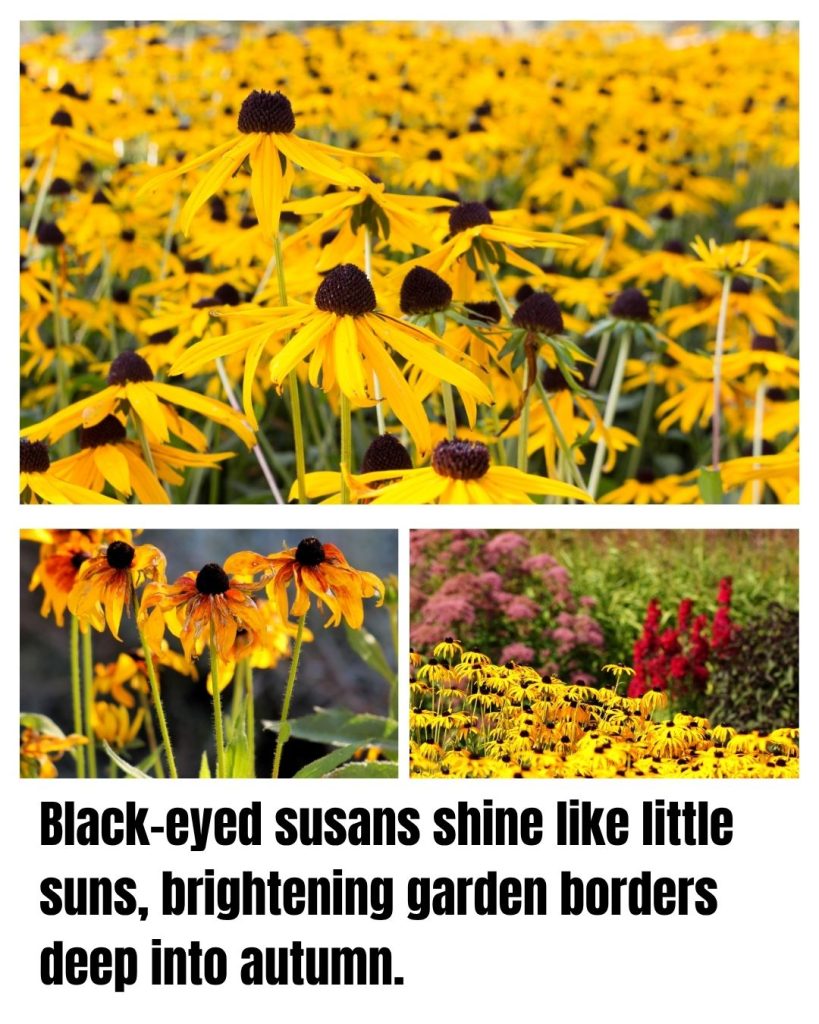
- Golden Petals, Dark Centers brighten beds from midsummer to frost.
- Deer Resistant– foliage and stems aren’t palatable to deer.
- Self-Seeding Habit– naturalizes easily in garden borders.
Black-eyed susans form clumps of bright yellow daisies that energize fall landscapes.
They pair well with coneflowers and asters for a sunny, pollinator-friendly border.
Thriving in USDA zones 3-9, they prefer full sun and average, well-drained soil. Cut back foliage in late winter to neaten.
19. Goldenrod (Solidago spp.)
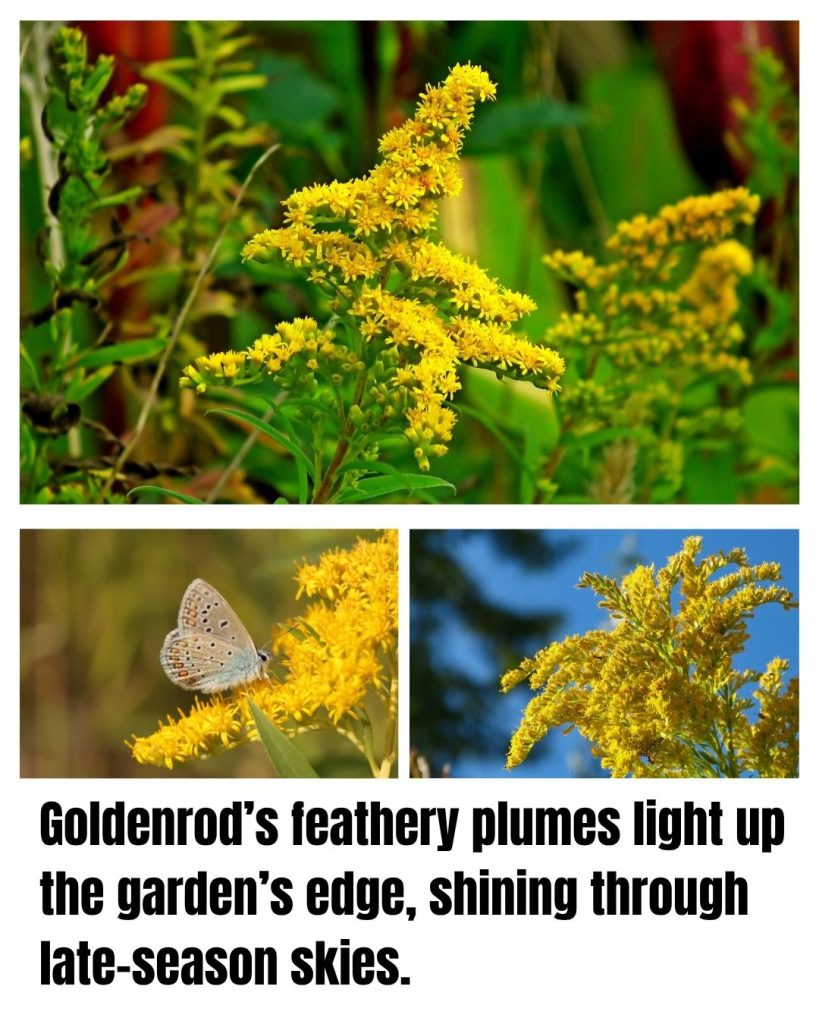
- Feathery Golden Plumes that light up the back of borders.
- Wildlife Food– provides nectar for bees and seed for birds.
- Tough and Resilient– thrives in poor soils and drought.
Goldenrod produces tall, plume-like clusters that burst with yellow late in the season.
It pairs well with asters and sedums for contrasting forms and complementary color.
Hardy in USDA zones 3-9, it prefers full sun and well-drained soil. Thin stands to prevent overcrowding.
20. Russian Sage (Perovskia atriplicifolia)
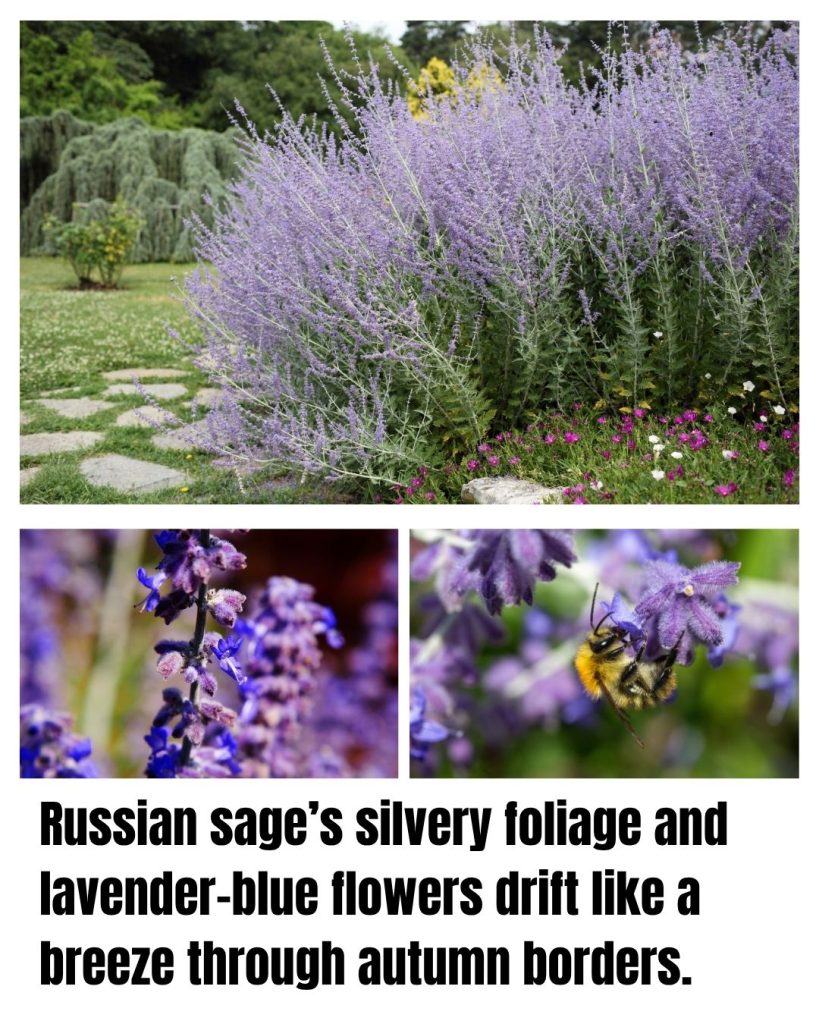
- Lavender-Blue Spires cascade on silver-green foliage for an airy effect.
- Drought and Heat Tolerant, it thrives in poor, dry soils.
- Pollinator Magnet– bees and butterflies love its nectar-rich blooms.
Russian sage forms mounds of aromatic, silvery foliage topped with airy flower spikes.
It pairs beautifully with lavender and ornamental grasses for soft texture and color contrast.
Hardy in USDA zones 5-9, it prefers full sun and well-drained soil. Cut back in spring to maintain shape and vigor.
21. Bluebeard (Caryopteris × clandonensis)
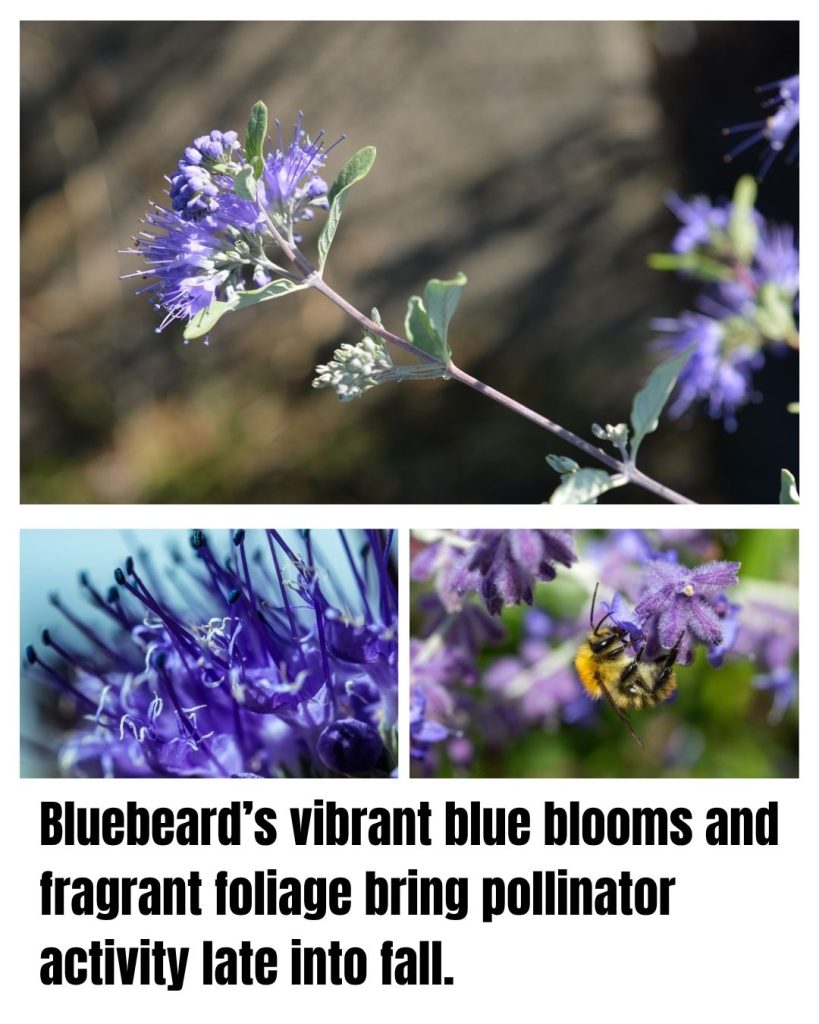
- Sky-Blue Flower Clusters crown aromatic gray-green foliage in late summer.
- Bee and Hummingbird Favorite– nectar-rich blooms attract wildlife.
- Fast-Growing– fills gaps quickly with airy, branching habit.
Bluebeard offers mounds of aromatic leaves topped with bright blue flower clusters. It pairs well with ornamental grasses and sedums for a dynamic late-season display.
Thriving in USDA zones 5-9, it prefers full sun and well-drained soil. Prune lightly after flowering to encourage a second bloom.
22. Turtlehead (Chelone glabra)
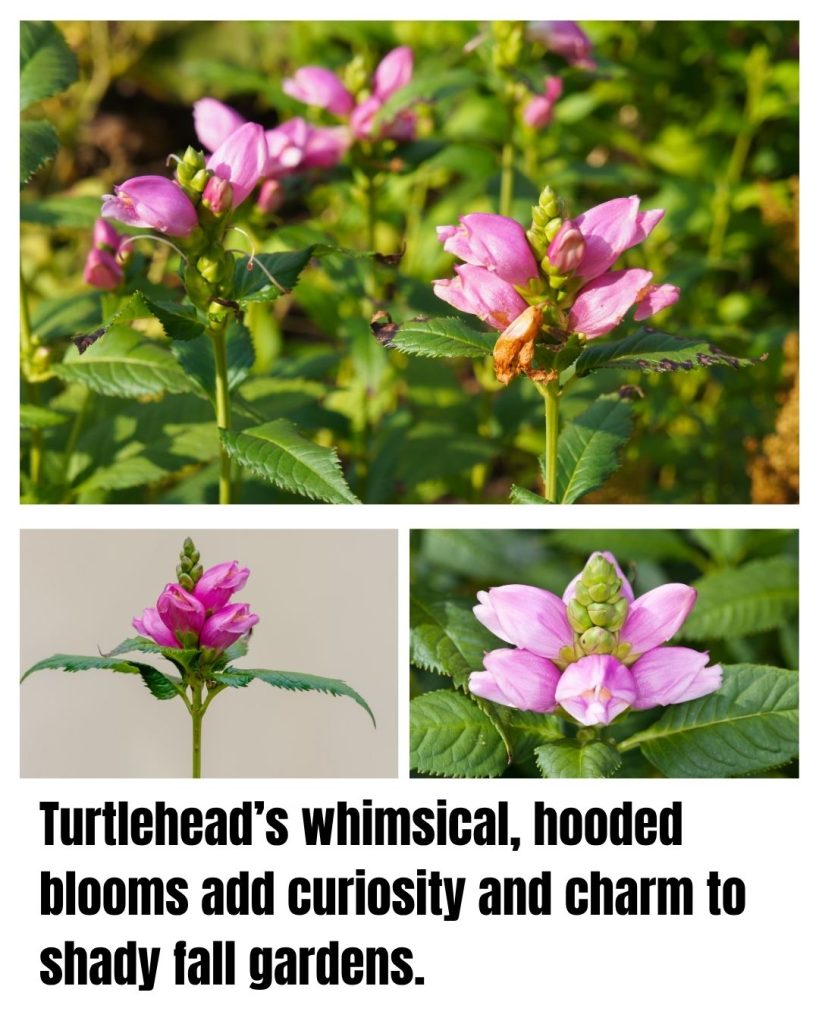
- Unique Hooded Blooms resemble turtle heads in pink or white.
- Shade Tolerant– thrives in moist, woodland conditions.
- Late-Season Interest– blooms from late summer into fall.
Turtlehead forms clumps of glossy foliage topped with distinctive hooded flowers.
It pairs well with ferns and hostas in shady borders or woodland gardens.
Growing in USDA zones 3-8, it prefers part shade and moist, rich soil. Divide every few years to prevent overcrowding.
23. Japanese Anemone (Anemone hupehensis)
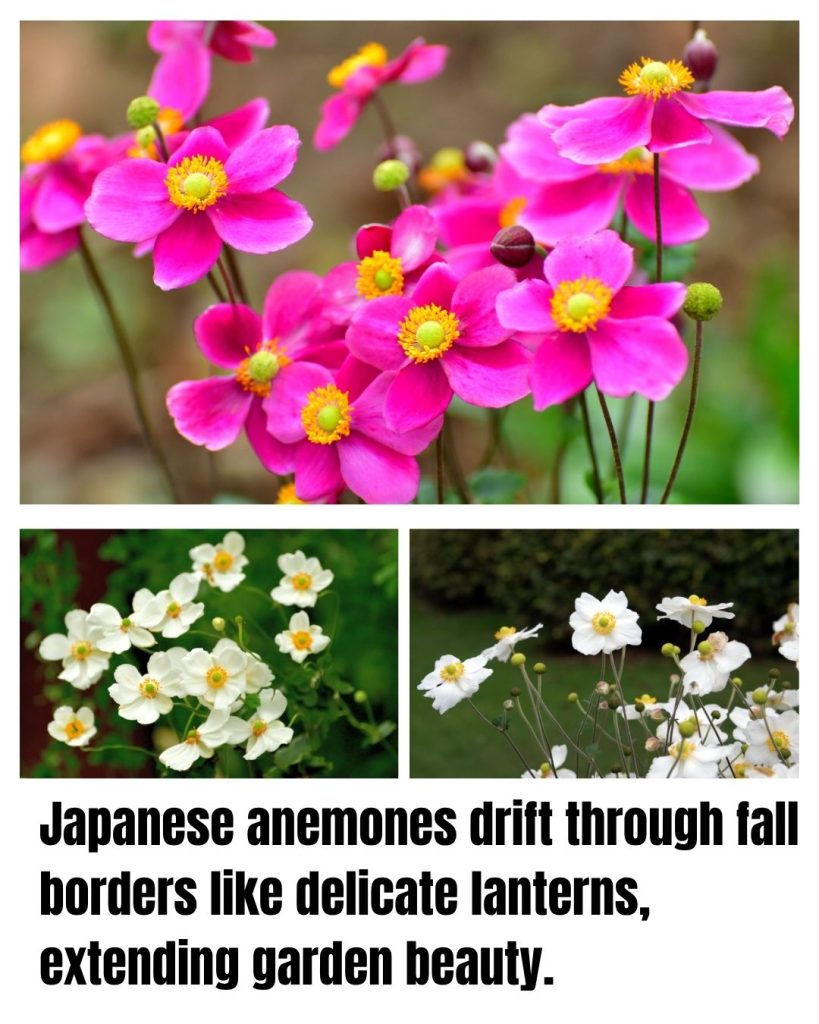
- Graceful Pink or White Flowers float on tall, slender stems.
- Shade to Part Sun tolerance for versatile planting.
- Long Blooming– flowers last for weeks into fall.
Japanese anemones display elegant, saucer-shaped blooms atop wiry stems. They pair well with ornamental grasses and ferns for an ethereal contrast.
Thriving in USDA zones 4-8, they prefer part shade and moist, well-drained soil. Stake stems if needed to prevent flopping.
24. Perennial Salvia (Salvia nemorosa)
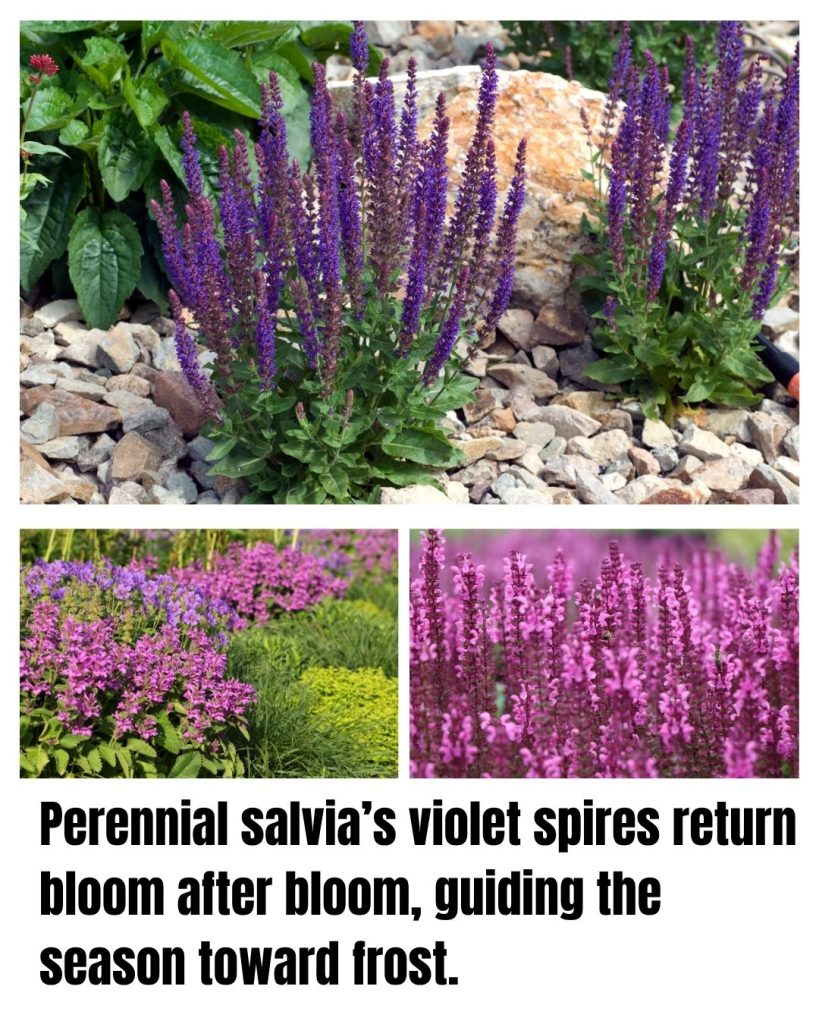
- Dense Violet Spikes rebloom if spent flowers are removed.
- Deer Resistant– unpalatable foliage keeps critters away.
- Easy Care– thrives in poor soils with minimal maintenance.
Perennial salvia forms neat mounds of aromatic foliage topped with flower spikes. It pairs well with nepeta and coreopsis for a classic cottage-garden look.
Hardy in USDA zones 4-8, it prefers full sun and well-drained soil. Deadhead regularly to extend bloom period.
25. Perennial Sunflower (Helianthus × multiflorus)
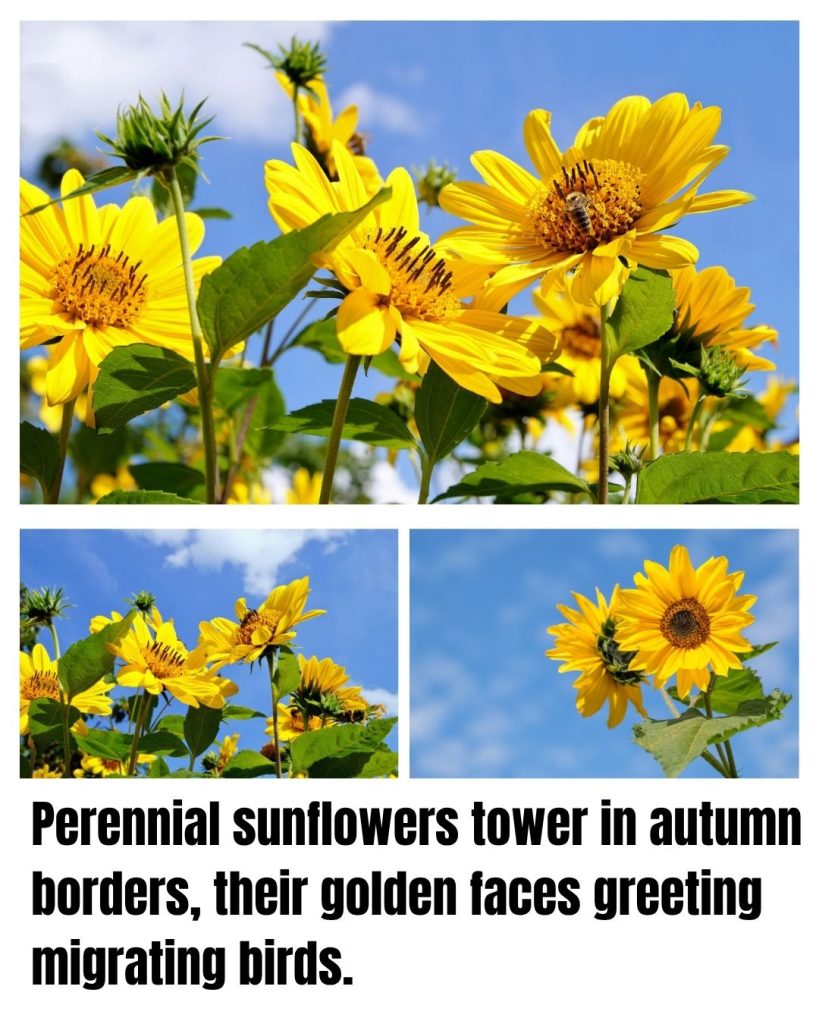
- Late-Blooming Daisies open in golden hues when others fade.
- Tall and Sturdy– reaches up to 6 feet for dramatic impact.
- Wildlife Friendly– seeds feed birds and small mammals.
Perennial sunflowers produce masses of golden daisy-like blooms on tall stalks. They pair well with asters and grasses for a naturalized meadow effect.
Thriving in USDA zones 4-9, they prefer full sun and average, well-drained soil. Stake as needed to keep upright.
With these 25 late-season stars in your garden, fall will feel like a second summer. Plant now, deadhead spent blooms, and watch your borders burst into color long after other flowers bow out.
Thank you for reading and happy planting!